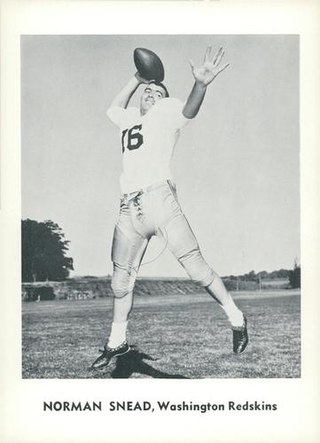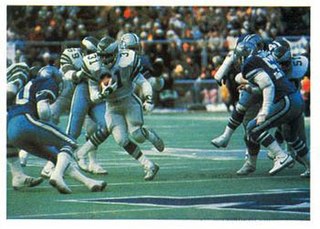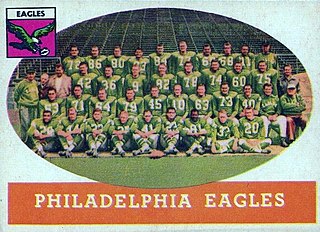Awards and honors
| | This section is empty. You can help by adding to it. (July 2010) |
| 1961 Philadelphia Eagles season | |
|---|---|
| Owner | Happy Hundred |
| Head coach | Nick Skorich |
| Home field | Franklin Field |
| Results | |
| Record | 10–4 |
| Division place | 2nd NFL Eastern |
| Playoff finish | Lost NFL Playoff Bowl (vs. Lions) 10–38 |
The 1961 Philadelphia Eagles season was the franchise's twenty-ninth season in the National Football League.
Since 1951, the Eagles have held their training camp at Hersheypark Stadium in Hershey, Pennsylvania.
The 1961 NFL draft and the 1961 AFL Draft were separate drafts, and players could end up being drafted by both leagues.
The 1961 NFL Draft, which involved fourteen teams choosing college players during twenty rounds, took place on December 27 and 28, 1960. It occurred after the Eagles' win in the NFL Championship Game on December 26.
The Eagles picked last as a result of the team's 10–2 season record in 1960. This was due to the rule at that time that teams be assigned their respective ranks in the selection process based on their previous season records. This meant that the Cleveland Browns picked ahead of the NFL runner-up, the Green Bay Packers.
This draft was also the first regular draft for the Dallas Cowboys, which had participated only in the 1960 NFL Expansion Draft that year. The Cowboys held the worst record in the NFL the previous season, but selected second in this draft due to the entry of the Minnesota Vikings into the league. The league also held a later expansion draft for the Vikings' franchise, which was awarded the first selection position in that draft.
The AFL draft was held on two dates that were two weeks apart at the end of the 1960 college season. Conducted prior to the bowl games, the first was a six-round draft held by phone. The second was held on December 5 and 6, 1960 for rounds seven through thirty. The Denver Broncos selected New Mexico State's Bob Gaiters as the overall first draft pick.
The Philadelphia Eagles lost its first-round pick to the AFL for the second year. About half of the Eagles' nineteen picks either signed with the AFL or remained in college to play their last year of eligibility.
| = Pro Bowler [1] | = AFL All-Star [2] | = Hall of Famer |
| Rd | PICK | PLAYER | POS | SCHOOL | AFL | Rd | Pick | Signed | |
|---|---|---|---|---|---|---|---|---|---|
| 1 | 14 | Art Baker | Fullback | Syracuse | Buffalo Bills from New York | 3rd | Buffalo | ||
| 2 | 28 | Bo Strange | Center | Louisiana State | Denver Broncos | 3rd | |||
| 3 | 36 | Jim Wright | Quarterback | Memphis State | New York | 1 | Dallas Texans | ||
| 3 | 42 | Don Oakes | Tackle | Virginia Tech | Boston Patriots | 21 | 162 | Eagles | |
| 4 | 53 | Dan Ficca | Guard | USC | San Diego | 29 | 162 | Oakland Raiders | |
| 4 | 56 | Pick taken by Green Bay | |||||||
| 5 | 70 | Pick taken by Detroit Lions | |||||||
| 6 | 84 | Ben Balme | Guard | Yale | |||||
| 7 | 98 | Irv Cross | Back | Northwestern | New York | 15 | 117 | Eagles | |
| 8 | 112 | Jim Beaver | Guard | Florida | |||||
| 9 | 126 | Wayne Fontes [3] | Running back | Michigan State | New York | 22 | 173 | New York Titans | |
| 10 | 140 | Luther Hayes | End | USC | San Diego | 27 | 215 | San Diego Chargers | |
| 11 | 154 | L.E. Hicks | Tackle | Florida | |||||
| 12 | 168 | Billy Majors [4] | Back | Tennessee | Buffalo Bills | 9 | 67 | Buffalo | |
| 13 | 182 | Don Jonas | Quarterback | Penn State | Eagles 1962 season then career in CFL | ||||
| 14 | 196 | Willie Fleming | Running back | Iowa | signed with BC Lions of CFL in 1959 | ||||
| 15 | 210 | Bobby Richards | Tackle | Louisiana State | Eagles 1962 season | ||||
| 16 | 224 | G. W. Clapp | Guard | Auburn | |||||
| 17 | 238 | Larry Lavery | Tackle | Illinois | |||||
| 18 | 252 | Nick Maravich | Tackle | North Carolina State | |||||
| 19 | 266 | Dick Wilson | Center | Penn State | |||||
| 20 | 280 [5] | Jacque MacKinnon [6] | Back | Colgate | |||||
| Week | Date | Opponent | Result | Record | Venue | Attendance |
|---|---|---|---|---|---|---|
| 1 | September 17 | Cleveland Browns | W 27–20 | 1–0 | Franklin Field | 60,671 |
| 2 | September 24 | Washington Redskins | W 14–7 | 2–0 | Franklin Field | 50,108 |
| 3 | October 1 | St. Louis Cardinals | L 27–30 | 2–1 | Franklin Field | 59,399 |
| 4 | October 8 | Pittsburgh Steelers | W 21–16 | 3–1 | Franklin Field | 60,671 |
| 5 | October 15 | at St. Louis Cardinals | W 20–7 | 4–1 | Busch Stadium | 20,262 |
| 6 | October 22 | at Dallas Cowboys | W 43–7 | 5–1 | Cotton Bowl | 25,000 |
| 7 | October 29 | at Washington Redskins | W 27–24 | 6–1 | D.C. Stadium | 31,066 |
| 8 | November 5 | Chicago Bears | W 16–14 | 7–1 | Franklin Field | 60,671 |
| 9 | November 12 | at New York Giants | L 21–38 | 7–2 | Yankee Stadium | 62,800 |
| 10 | November 19 | at Cleveland Browns | L 24–45 | 7–3 | Cleveland Municipal Stadium | 68,399 |
| 11 | November 26 | Dallas Cowboys | W 35–13 | 8–3 | Franklin Field | 60,127 |
| 12 | December 3 | at Pittsburgh Steelers | W 35–24 | 9–3 | Forbes Field | 21,653 |
| 13 | December 10 | New York Giants | L 24–28 | 9–4 | Franklin Field | 60,671 |
| 14 | December 17 | at Detroit Lions | W 27–24 | 10–4 | Tiger Stadium | 44,231 |
Note: Intra-conference opponents are in bold text.
| NFL Eastern Conference | |||||||||
|---|---|---|---|---|---|---|---|---|---|
| W | L | T | PCT | CONF | PF | PA | STK | ||
| New York Giants | 10 | 3 | 1 | .769 | 9–2–1 | 368 | 220 | T1 | |
| Philadelphia Eagles | 10 | 4 | 0 | .714 | 8–4 | 361 | 297 | W1 | |
| Cleveland Browns | 8 | 5 | 1 | .615 | 8–3–1 | 319 | 270 | T1 | |
| St. Louis Cardinals | 7 | 7 | 0 | .500 | 7–5 | 279 | 267 | W3 | |
| Pittsburgh Steelers | 6 | 8 | 0 | .429 | 5–7 | 295 | 287 | L1 | |
| Dallas Cowboys | 4 | 9 | 1 | .308 | 2–9–1 | 236 | 380 | L4 | |
| Washington Redskins | 1 | 12 | 1 | .077 | 1–10–1 | 174 | 392 | W1 | |
| Round | Date | Opponent | Result | Venue | Attendance |
|---|---|---|---|---|---|
| Playoff Bowl | January 6, 1962 | Detroit Lions | L 10–38 | Orange Bowl | 25,612 |
| | This section is empty. You can help by adding to it. (July 2010) |

The National Football League draft, also called the NFL draft or (officially) the Annual Player Selection Meeting, is an annual event which serves as the most common source of player recruitment in the National Football League. Each team is given a position in the drafting order in reverse order relative to its record in the previous year, which means that the last place team is positioned first and the Super Bowl champion is last. From this position, the team can either select a player or trade its position to another team for other draft positions, a player or players, or any combination thereof. The round is complete when each team has either selected a player or traded its position in the draft. The first draft was held in 1936, and has been held every year since.

The 1966 NFL season was the 47th regular season of the National Football League, and the first season in which the Super Bowl was played, though it was called the AFL-NFL World Championship Game. The league expanded to 15 teams with the addition of the Atlanta Falcons, making a bye necessary one week for each team.
The 1960 NFL season was the 41st regular season of the National Football League.

Norman Bailey Snead was an American professional football player who was a quarterback in the National Football League (NFL). He played for the Washington Redskins, Philadelphia Eagles, Minnesota Vikings, New York Giants, and San Francisco 49ers. He played college football for the Wake Forest Demon Deacons and was selected in the first round of the 1961 NFL Draft with the second overall pick.
The 1961 NFL draft took place at the Warwick Hotel in Philadelphia on December 27–28, 1960. The league would later hold an expansion draft for the Minnesota Vikings expansion franchise. This draft was also the first regular draft for the Dallas Cowboys as they had only participated in the 1960 NFL expansion draft that year.
During the first seven years of existence (1960–1966) of the American Football League, the AFL and the NFL held separate, competing drafts for college football talent.

The 1980 Philadelphia Eagles season was the team's 48th season in the National Football League (NFL). The Eagles won twelve of their sixteen games, winning their division for the first time in twenty years. The Eagles started the season winning eleven of their first twelve games, only to finish the season losing three of their final four. Still, the 12–4 record was good enough to win the NFC East division title for the first time in franchise history since the NFC East had been formed.

The 1979 Philadelphia Eagles season was the franchise's 47th season in the National Football League (NFL).
The 1960 Philadelphia Eagles season was the franchise's 28th season in the National Football League, and finished with the Eagles' win over the Green Bay Packers in the NFL championship game to get their third league title. The victory over the Packers was also the first and only playoff defeat of the Packers' Vince Lombardi's coaching career. The 1960 season was the Eagles' first postseason appearance since their last NFL championship season of 1949. It was their only postseason appearance in the 28 seasons from 1950 to 1977, and their last NFL title until their victory in Super Bowl LII, 57 years later.
The 1964 Philadelphia Eagles season was the franchise's thirty-second season in the National Football League.
The 1965 Philadelphia Eagles season was the franchise's thirty-third season in the National Football League.
The 1966 Philadelphia Eagles season was the franchise's 34th season in the National Football League.

The 1995 Philadelphia Eagles season was their 63rd in the National Football League (NFL). The team improved upon their previous output of 7–9, going 10–6 under new head coach Ray Rhodes and qualifying for the playoffs for the first time in three seasons.
The 1961 NFL expansion draft was a National Football League (NFL) draft in which a new expansion team, named the Minnesota Vikings, selected its first players. That selection was provided by the expansion draft, held on January 26, 1961.
The 1959 Philadelphia Eagles season was the franchise's 27th season in the National Football League. They improved on their previous output of 2–9–1, winning seven games. The team failed to qualify for the playoffs for the tenth consecutive season.

The 1958 Philadelphia Eagles season was the franchise's 26th season in the National Football League (NFL). They failed to improve on their previous output of 4–8, winning only two games. The team failed to qualify for the playoffs for the ninth consecutive season. In the offseason, Vince Lombardi was offered the Eagles head coaching position but he refused it. He opted to stay as the Offensive Coordinator of the New York Giants.
The 1955 Philadelphia Eagles season was their 23rd in the league. They failed to improve on their previous output of 7–4–1, winning only four games. The team failed to qualify for the playoffs for the sixth consecutive season. 1955 marked the end of an era, as the last remaining Phil-Pitt Steagle, longtime player Bucko Kilroy, retired after 13 seasons in the NFL, all of them with the Eagles, going back to when they were known as the Steagles.
The 1950 Philadelphia Eagles season was their 18th in the league. The team failed to improve on their previous output of 11–1, winning only six games. The team failed to qualify for the playoffs for the first time in four seasons.
The 1945 Philadelphia Eagles season was the Eagles' 13th in the league. The team failed to improve on its previous output of 7–1–2, losing three games.